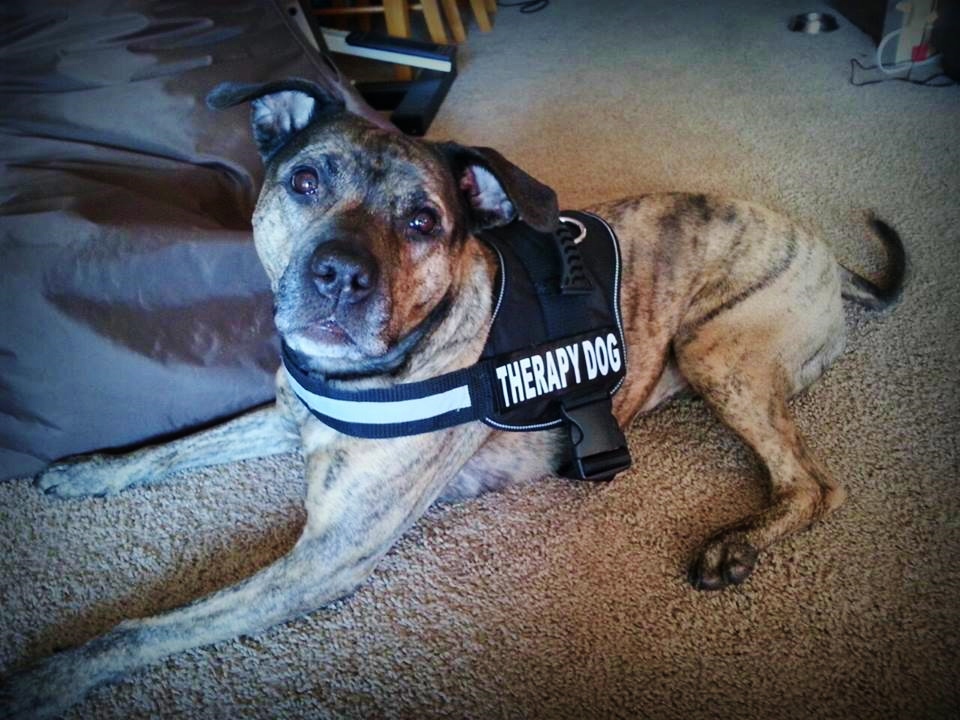By Nadine Moedt (The Cascade) – Email
Print Edition: April 2, 2014

Janine Pijpstra would like to be able to bring her dog to school.
Pijpstra, who is currently heading into her third year at UFV, is in the midst of a practicum in social work. Her goal? To get her trained therapy dog, Jamie, into Baker house.
Pijpstra hopes to make Jamie accessible for students overwhelmed or struggling with settling in at UFV.
“She would be perfect for new students, or students with mental health issues, or [those dealing with] the difficulties of coming out,” Pijpstra says.
Therapy dogs work as a social lubricant, giving the mentor — in this case, Pijpstra — and the student who needs help something to talk about to break the ice. Jamie has been certified by the St. John Ambulance therapy dog program, which employs rigorous testing to make sure the dogs are, as Pijpstra describes it, “bullet proof.”
St. John’s tests the dog’s reaction to typical hospital settings, as well as more trying and distressed situations. Pijpstra says that at one point, a tester dressed up in a hospital robe and started “screaming and hitting the dogs.”
“She can’t react to that,” Pijpstra says. “She can’t react if somebody steps on her, pushes her, [or] takes her treat away.”
There is also testing for any signs of aggression with other dogs or with people with disabilities and in wheelchairs. Evaluators also watch how the owner interacts with the dog, and how well the dog responds to the commands of the owner. The owners are also given an orientation on how to act with patients.
According to the St. John’s website, certified therapy dogs like Jamie provide a plethora of benefits to visitors, including a reduction in stress and blood pressure levels. The dogs offer unconditional affection, which calms and comforts visitors.
Pijpstra feels that having Jamie accessible to Baker House students would be beneficial to the residents there. Moving out on one’s own is a difficult and often isolating experience, as Pijpstra knows all too well.
“I would have loved to have something like this [in my first year]. To have someone take you aside and tell you it’s not that bad. The first year is always hard,” she says.
Pijpstra and Jamie hope to be available once or twice a week to residents, where they could go for advice from an older student or just a bit of affection from a very special dog.
Pijpstra rescued Jamie — whom she describes as an “all-American shelter dog” — several years ago.
A therapy dog has to be born with a distinct compassionate disposition, something Pipstra saw in the abandoned Jamie.
“I noticed right away that she had potential,” Pijpstra says.
Pijpstra has worked with therapy dogs before with heroin addicts and found great success.
“If [addicts] don’t want to talk to you, they shut down. So the dog goes up to them and they start talking to the dog.”
Soon a bond is formed, both with the dog and subsequently with the dog’s owner. The patient finds something relatable in the dog and this relaxes and opens them up.
“It always calms them down if they’re nervous or if they’re aggressive,” Pijpstra says. “It’s amazing … Jamie has an amazing talent. I’ve worked with quite a few [dogs] and she’s special.”
There is a distinct difference between Jamie and Mac, the therapy dog at UFV’s counselling department, Pijpstra says.
“Jamie is a little more punchy and outgoing. These Labrador or retriever dogs are really calm … Jamie will come to you, she’ll lick you. She’s perfect that way.”
Jamie’s job is to draw visitors out, and get them talking, Pijpstra says.
According to Pijpstra, there are many other universities across Canada who have a therapy dog in residence.
“They’re all happy about it, they all love it. It works perfect for stress of exams, for anything.”
While Jamie might be a wonderful addition to Baker house, the process of getting approval to do that has been a long one.
“You have to go bottom-up,” Pijpstra says. “It’s dragging. All you want to do is help, and you still have to beg for it.”


